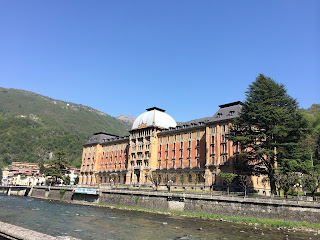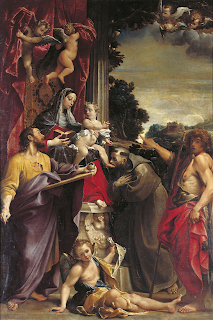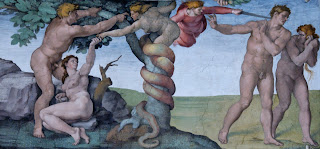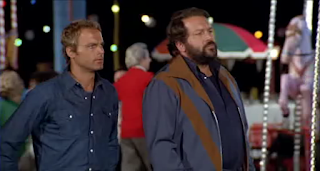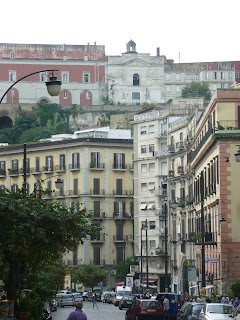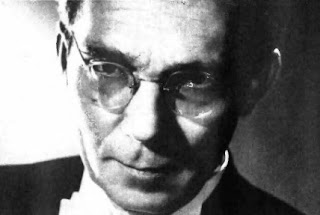Mapped Pacific on four-year epic journey
 |
| Alessandro Malaspina spent much of his life in the employ of the Spanish navy |
Like Vespucci and Columbus, Malaspina sailed under the flag
of Spain, whose king, Charles III, was an enthusiastic supporter of scientific
research and exploration.
He spent much of his life as an officer in the Spanish navy,
and it was after completing an 18-month circumnavigation of the world on behalf
of the Royal Philippines Company between September 1786 and May 1788 that he
proposed to the Spanish government that he make an expedition to the Pacific
similar to those undertaken by the British explorer James Cook and the Frenchman Comte de la Pèrouse.
His proposal was accepted in part after word reached Spain
that a Russian expedition was being prepared with the objective of claiming
territory on the northwest coast of North America that had already been claimed
by Spain.
After two years of preparation, the Malaspina Expedition, made up of two
frigates - one named Descubierta in honour of Cook's Discovery - that he had built specially for the expedition, set sail from Cadiz on July
30, 1789, bound for South America. They rounded Cape Horn and sailed up the
Pacific coast to Mexico.
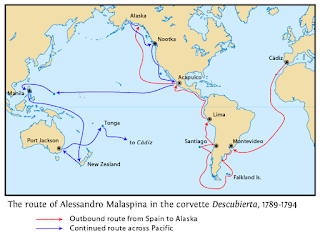 |
| The route followed by Malaspina's party |
At this point, Malaspina received word that King Charles IV,
who had inherited the throne following the death of Charles III in 1788, wanted
him to detour to Alaska and survey the coastline to find out whether a rumoured
northwest passage from the Pacific coast to the Atlantic existed.
Malaspina’s vessels anchored off Alaska for a month, studying
local tribespeople and collecting and recording numerous plants. Today, a
glacier between Yakutat Bay and Icy Bay is known as the Malaspina Glacier.
Malaspina knew that Cook had surveyed the west coast of
Prince William Sound about 15 years earlier had not found a northwest passage. He was not convinced it did exist and, rather than spend more time looking after failing to find evidence of it, the Italian set sail for the Spanish
outpost at Nootka Sound on Vancouver Island, established two years earlier.
His men surveyed and mapped the area around Nootka Sound more
accurately than had previously been achieved, and made more botanical studies.
He moved south again to explore the mouth of the Columbia River, near where
Seattle is now.
 |
| Malaspina's two frigates, drawn by Fernando Brambilla, one of a number of artists who accompanied the expedition |
Eventually, he headed back along the coast to Acapulco in Mexico, before crossing the ocean to explore the Philippines, New Zealand and Australia,
before returning to Spain, arriving in arriving in Cadiz in September 1793, to
be greeted with great acclaim.
Malaspina was elevated to fleet-brigadier in the Spanish
navy but his status as a national hero collapsed, however, over the next few
years as the political climate in Spain changed following the French
Revolution. He became involved with a plot to overthrow the prime minister and
was arrested.
He was stripped of his rank and sentenced to life
imprisonment. He was released after eight years when Napoleon Bonaparte, who
had taken control of the territory around his home town in Italy, intervened on his
behalf. But the years in jail, often in solitary confinement, had destroyed his
health.
Malaspina’s documentation from the expedition was taken from
him during his incarceration and his proposed seven-volume account of the journey was left unpublished.
He returned to Italy, settling in Pontremoli in the area of
northern Tuscany at that time known as the Kingdom of Etruria, where he died in
1810 at the age of 55. Although some of
his journals had by then been published, it was not until 1987 – 177 years after
his death - that the first volume of his full account was published by the
Spanish Naval Museum.
The last of the seven was published in 1999 and the full
extent of Malaspina’s achievement could finally be appreciated, so that he
could take his place alongside Columbus and Vespucci as one of history’s great
explorers.
 |
| Mulazzo has a monument to the poet Dante Alighieri |
Travel tip:
Mulazzo is a village in the part of northwestern Tuscany
known as Lunigiana, an area of great beauty that was a favourite of the poet
Dante Alighieri. Although he would often retreat
to the Monastery of Santa Croce Corvo on the coast near Marina di Carrara, he
also enjoyed the peace and solitude of the mountain regions inland and visited
Mulazzo, which stages a Dante celebration every year. Mulazzo also has a study centre dedicated to
the career of Alessandro Malaspina.
 |
| Pontremoli sits alongside the Magra river |
Travel tip:
Pontremoli has the status of city even though its population
is fewer than 8,000. Built on the site
of a settlement first noted in 1,000 BC, its position and fertile landscape in
the Magra valley made it a strategically important location and consequently it
changed hands many times, owned by a succession of powerful families until
1508, when it became part of an area controlled by the French. Subsequently it was taken over by the Holy
Roman Empire, the Spanish, the Republic of Genoa, the Medici Grand Duchy of
Tuscany and the French again before becoming part of the unified Italy. Malaspina had a palace there.



